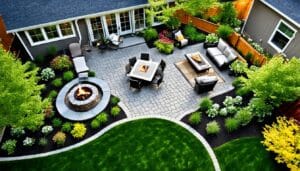Not all desert landscapes are bathed in relentless sunlight. Many regions have shaded areas that require thoughtful plant selection. Fortunately, a variety of succulents, cacti, and perennials can thrive in partial shade. They offer a range of colors, textures, and low-maintenance benefits for desert gardeners.
From the lush fronds of the Asparagus fern to the fragrant blooms of the Star jasmine, these plants can transform shaded corners into verdant oases.
While full sun is the ideal for many desert species, a surprising number of succulents, cacti, and flowering perennials can adapt to partial shade conditions. By understanding the specific needs and adaptations of these versatile plants, desert enthusiasts can expand their garden palette. They can create visually stunning, low-water landscapes that provide year-round interest.
Key Takeaways
- Many desert plants can thrive in partial shade, offering a range of colors, textures, and low-maintenance benefits.
- Asparagus fern, Star jasmine, and Ponytail palm are examples of shade-tolerant desert plants.
- Partial shade plants can transform shaded corners into vibrant, water-wise gardens.
- Understanding the adaptations of shade-loving desert plants is key to successful cultivation.
- Incorporating partial shade plants expands the design possibilities for desert landscapes.
Understanding Shade-Tolerant Desert Plants
In the American Southwest, some desert plants love the shade. They bring greenery and color to dry lands. These arid climate shade lovers save water and need little care. They’re perfect for desert gardens wanting shade.
Definition of Partial Shade in Desert Environments
Partial shade in deserts means light that’s not too strong. It’s like getting 2 to 4 hours of sun a day. You find it in places like canyons or under trees, where plants can grow well.
Benefits of Growing Shade-Adapted Desert Plants
- Water conservation: These plants save water, so you don’t have to water them often.
- Low maintenance: They need less care, like no pruning or fertilizing, making gardening easy.
- Unique aesthetic appeal: They have special shapes and colors, making gardens look interesting.
- Wildlife support: They attract birds and insects, helping nature.
Natural Habitat Considerations
Knowing where these plants grow in nature helps gardeners. They do best in places with filtered light, like canyons or under trees. This knowledge helps choose and place plants right in shaded desert gardens.
Desert Plants That Do Not Need Full Sun: Essential Guide
Finding the right plants for shaded desert areas can change the game for gardeners and landscapers. Many desert plants love full sun, but some thrive in the shade. These low light desert flora and shaded desert vegetation add beauty and texture to gardens in partial shade.
Asparagus fern (Asparagus aethiopicus) is a great pick, growing 2-3 feet tall and wide. It needs little care and does well in low-light desert conditions. It brings a lush, feathery look to any spot.
Star jasmine (Trachelospermum jasminoides) is another excellent choice. It can climb or spread as a ground cover. With its sweet white flowers, it brightens up shaded spots.
The ponytail palm (Beaucarnea recurvata) is a tall, adaptable plant. It can grow up to 30 feet tall. It’s perfect for shaded desert gardens, adding height and beauty.
| Plant | Growth Habit | Mature Size | Light Requirements |
|---|---|---|---|
| Asparagus Fern | Shrub | 2-3 feet tall and wide | Partial shade |
| Star Jasmine | Climber/Ground Cover | Varies | Partial shade |
| Ponytail Palm | Tree | Up to 30 feet tall | Partial shade |
These plants show how low light desert flora and shaded desert vegetation can transform desert gardens. They give gardeners many options to beautify their spaces, even in the shade.
Adaptations of Desert Plants to Low Light Conditions
Desert plants have evolved amazing ways to grow in low light. They have special structures, ways to save water, and growth patterns. These help them do well in places with less sunlight.
Structural Modifications
One key adaptation is bigger leaf surfaces. This lets them catch more light, even in shaded spots. It helps them make food through photosynthesis.
Water Conservation Mechanisms
Desert plants also have special stomata. These are the tiny holes on leaves that control gas exchange. They help the plants use less water, which is important in dry climates.
Growth Patterns in Shade
When sunlight is scarce, desert plants grow differently. They get longer stems and wider leaves. This helps them reach for light and absorb more of it for photosynthesis.
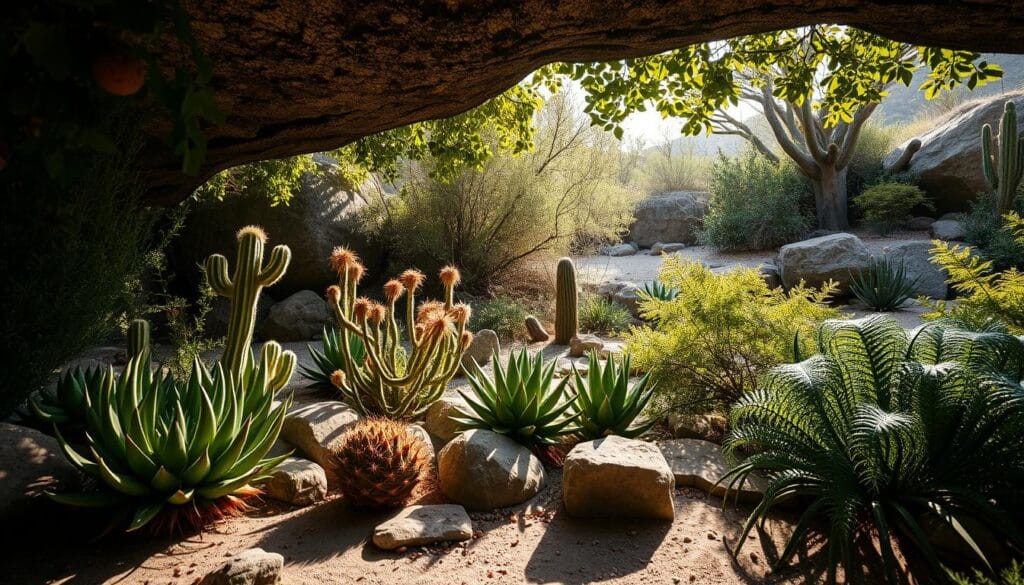
These special traits let desert plants grow well in shaded areas. They’re great for gardens and landscaping in places with less sunlight.
Best Succulents and Cacti for Shaded Areas
Looking for the right succulents and cacti for shaded desert spots? Some plants really stand out. The night-blooming cereus (Peniocereus greggii) blooms beautifully in summer, even in partial shade. The variegated agave, like Agave desmettiana, also does well in partial shade. It keeps its bright leaves safe from too much sun.
While most succulents and cacti need lots of sunlight, some can handle less light. The jade plant and devil’s backbone do well in partial sun or filtered light. The string of pearls succulent prefers partial shade. The string of hearts is great for shaded spots because it doesn’t need much water.
- The stonecrop succulent is very adaptable, growing well in both bright and full shade.
- The lace aloe is known for being tough, surviving in shady spots and cold temperatures.
- For terrariums, the Aeonium Kiwi is a good choice. The ponytail palm is perfect as a houseplant in shaded areas.
With so many shade-loving succulents and cacti, you can create beautiful desert-inspired gardens in shady spots. Knowing what each plant needs helps you bring desert beauty to any space, indoors or outdoors.
| Succulent/Cactus | Light Requirements | Unique Characteristics |
|---|---|---|
| Night-blooming cereus (Peniocereus greggii) | Partial shade | Produces spectacular, fragrant flowers in summer |
| Variegated agave (Agave desmettiana) | Partial shade | Colorful foliage protected from intense sun exposure |
| Jade plant | Partial sun or filtered light | Thrives in lower light conditions |
| Devil’s backbone | Partial sun or filtered light | Tolerates lower light environments |
| String of pearls | Partial shade | Requires only partial shade |
| String of hearts | Low water conditions | Tolerant of low water environments |
| Stonecrop | Bright light and full shade | Highly adaptable to different light conditions |
| Lace aloe | Shady conditions and low temperatures | Exceptionally hardy, surviving in challenging environments |
| Aeonium Kiwi | Suitable for terrariums | Thrives in low-light, enclosed settings |
| Ponytail palm | Suitable as a statement houseplant in shaded areas | Adds a touch of desert charm to indoor spaces |
By using these desert plants that do not need full sun, you can make stunning, easy-to-care-for gardens in shady spots. These shade tolerant desert plants offer many choices for different needs and tastes. They let you bring desert beauty into shaded indoor or outdoor spaces.
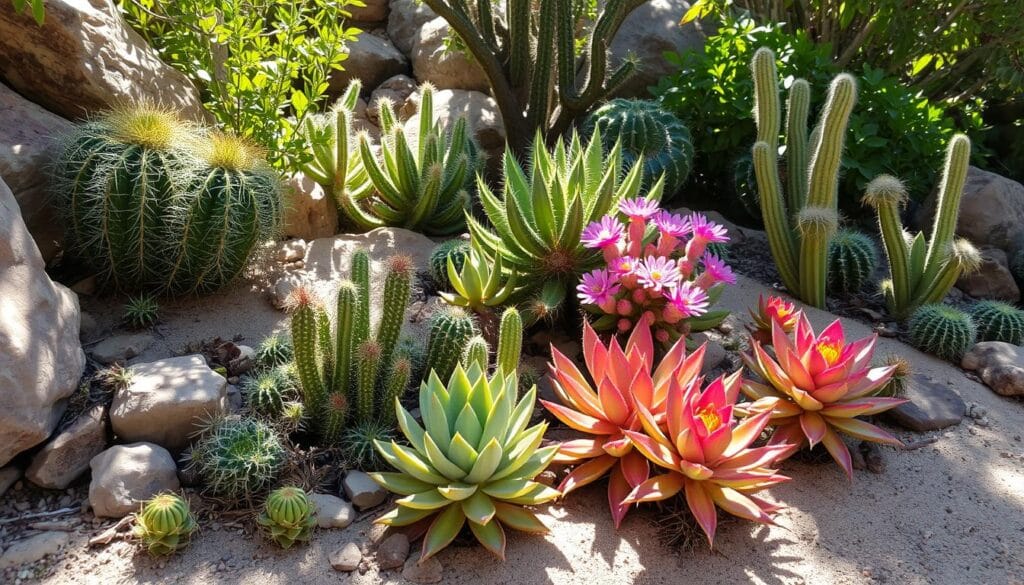
Flowering Desert Plants for Partial Shade
Gardeners in desert areas can find many vibrant plants for shaded spots. The star jasmine and desert salvias are great choices. They attract pollinators and add beauty to your garden.
Star Jasmine and Its Care Requirements
The Trachelospermum jasminoides, or star jasmine, loves partial shade. It blooms with sweet white flowers in spring and early summer. This drought-tolerant vine needs regular water and can grow well in different light conditions.
Desert Salvias for Shade Gardens
Desert salvias, like the Salvia greggii, are perfect for partial shade. They attract pollinators and bloom in warm months. The Conoclinium greggii, or Gregg’s Mistflower, blooms more in shade.
Seasonal Blooming Patterns
These desert plants bloom at different times. Star jasmine blooms in spring and early summer. Salvias bloom longer in warm months. This variety makes shade gardens beautiful all year.
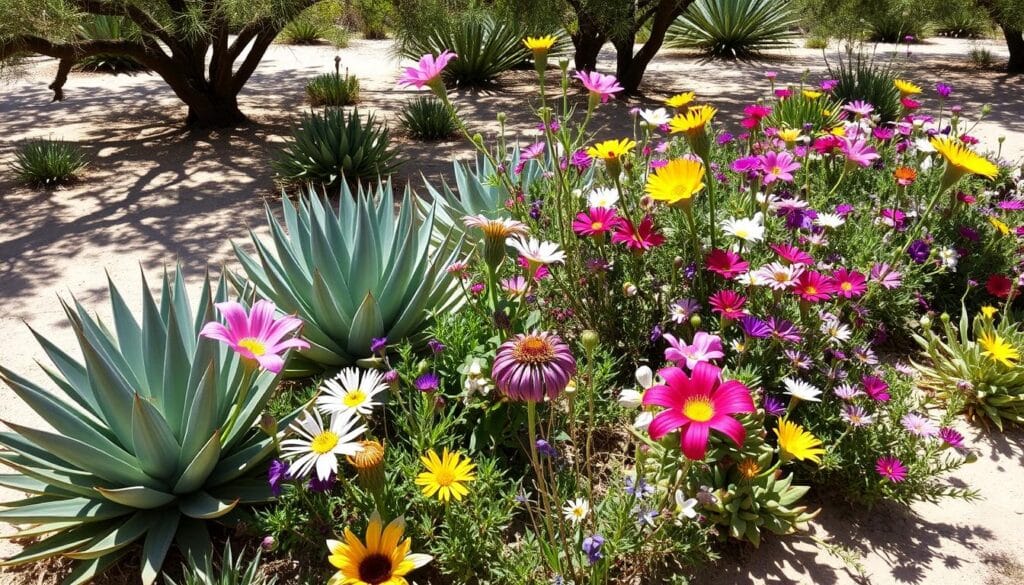
“Incorporating these resilient, shade-tolerant perennials into your desert garden design can add both beauty and functionality to your outdoor oasis.”
Desert Vines and Ground Covers for Shaded Spaces
Finding plants that do well in partial shade in the desert can be tough. But, there are many arid climate shade lovers and desert understorey greenery options. These can add beauty and cover to your shaded area. Let’s look at some top desert vines and ground covers for shaded spots.
The climbing milkweed (Sarcostemma cynanchoides) is a great choice for partial shade. It’s a hardy vine that does well in these conditions. The crossvine (Bignonia capreolata) also works well, adding a lush look to shaded areas. For a splash of color, try the Queen’s wreath vine (Antigonon leptopus), or coral vine, which loves filtered sunlight and draws pollinators.
For ground covers, there are many arid climate shade lovers and desert understorey greenery options. They can make shaded areas look lush and easy to care for. Here are some top picks:
- Basket-of-gold (Aurinia saxatilis)
- Amethyst in Snow (Phlox subulata)
- Creeping phlox (Phlox stolonifera)
- Angelina sedum (Sedum rupestre ‘Angelina’)
- Nepeta (Nepeta spp.)
- Creeping thyme (Thymus serpyllum)
- Wall germander (Teucrium chamaedrys)
- Creeping juniper (Juniperus horizontalis)
- Rock cotoneaster (Cotoneaster horizontalis)
- Bunchberry (Cornus canadensis)
By adding these arid climate shade lovers and desert understorey greenery to your garden, you can make a shaded oasis. This oasis will thrive even in the desert’s tough conditions.
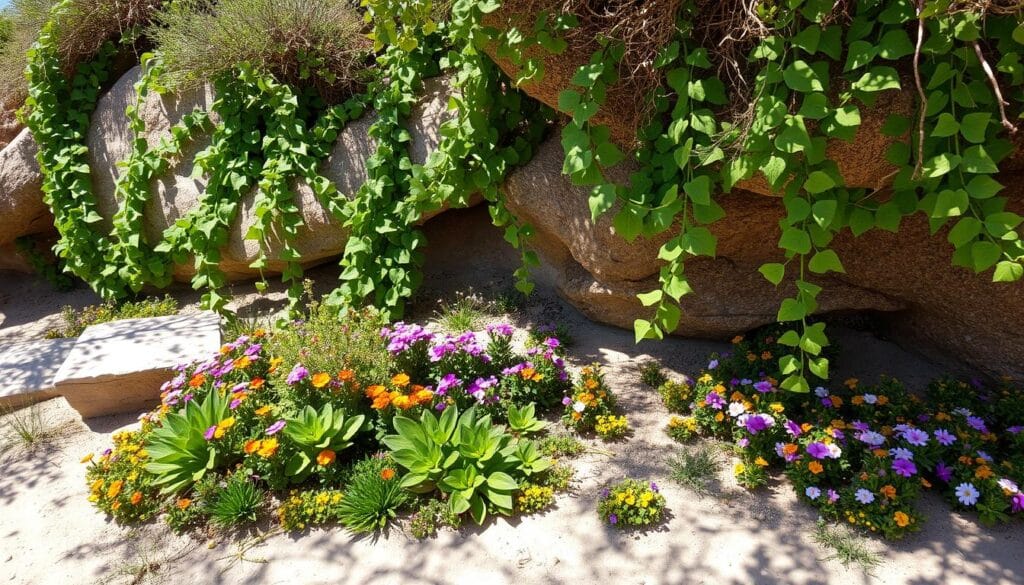
“Desert plants are not only low-maintenance and drought-tolerant, but they also support local wildlife and contribute to a more sustainable landscape.”
Native Desert Grasses That Thrive in Low Light
Native grasses are great for desert landscaping, especially in partial shade or low light. The bamboo muhly (Muhlenbergia dumosa) is a top choice. It grows well in shaded spots.
Bamboo Muhly Cultivation
Bamboo muhly grows smaller in shade but still looks beautiful. It’s perfect for shaded spots or areas with little sun in desert gardens.
Maintenance Requirements
Keeping bamboo muhly in shade is easy. Just trim it lightly now and then to keep its shape. This low light desert flora does well in shaded desert vegetation.
Seasonal Care Tips
- Water less in winter to avoid overwatering and help it rest.
- Watch for pests, but they’re less common in shade.
- Prune in spring to encourage new growth and shape.
Adding native grasses like bamboo muhly to shaded desert spots is a smart move. They add beauty and resilience to low light desert flora and shaded desert vegetation.
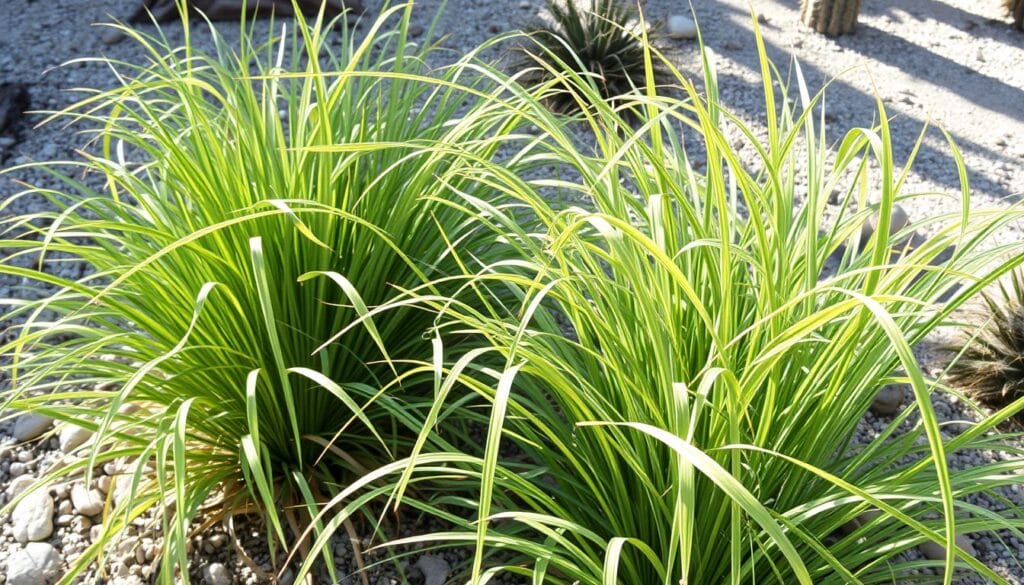
Water Management for Shade-Loving Desert Plants
Proper water management is crucial for desert plants that love shade. These plants need less water than those in full sun. Finding the right balance is key for their health.
Water your shade-loving desert plants deeply but not too often. This helps their roots grow deep, searching for water. Use drip irrigation or soaker hoses to save water and prevent waste.
Check the soil moisture in shaded areas often. These areas hold water longer. Adjust your watering based on this, watering less in cooler months. Also, make sure the soil drains well to avoid waterlogging, which harms these desert plants that do not need full sun.
Understanding the water needs of partial shade plants helps you create a beautiful desert garden. It’s low-maintenance and showcases the beauty and strength of these plants.
Creating a Desert Shade Garden Design
Designing a desert shade garden needs careful thought on plant choice and layout. Use a mix of shade tolerant desert plants and smart design to make a lush oasis. This oasis will flourish even in spots with little sunlight.
Begin by picking plants with different textures and heights for interest. Add elements like rocks, decorative containers, or small water features for more beauty. Light-colored mulch can also brighten shaded areas and match your desert plants’ unique leaves.
When placing your plants, think about how sunlight changes throughout the year. This ensures your plants grow well and bloom at the right times. Mix succulents, flowering perennials, and native grasses for a stunning landscape. This way, your desert shade garden will be beautiful, easy to care for, and good for the environment.



